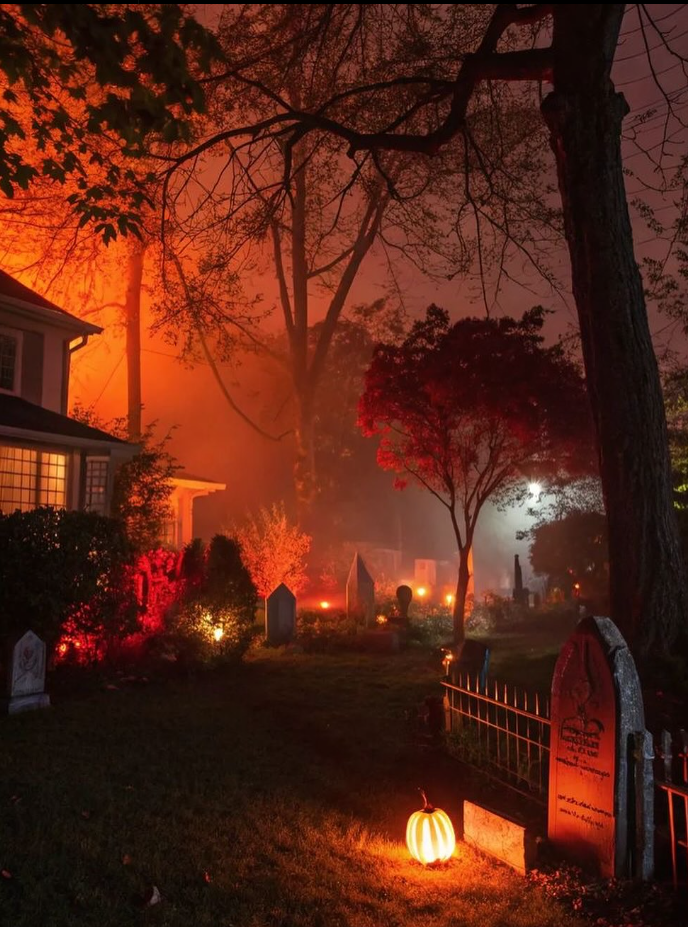
Oct 29, 2025 | Belen Ponce Leal | Lifestyle Editor
Halloween is known throughout the United States as the spookiest time of the year; the time when children go door-to-door wearing costumes that range from cute to scary, candy is given out and scares are plotted throughout the night. Despite its popularity, many don’t know the origins of this holiday that has developed and changed throughout the centuries.
The origins of Halloween can be traced back to the ancient Celtic festival of Samhain, which is still celebrated today by Pagans. Over 2,000 years ago, the Celts and the druids celebrated the new year Nov. 1. Samhain, which translates to “summer’s end” in Gaelic, marked the end of the harvest, meaning winter was about to begin. Winter was seen as a time of death, where the veil between the living and the dead thins to allow supernatural forces to wander the earth. The people would gather to burn crops and offer animals as sacrifices to the Celtic deities. Additionally, those who were thinking of their lost loved ones would use candles and bonfires to guide them to the afterlife.
Others would wear costumes to scare the bad spirits and demons away. However, some believed that doing this would allow them to be able to tell each other’s future. The Celtic priests believed that due to the presence of otherworldly beings on the earth, their predictions would hold more weight. After the festival was over, they would take flames from the bonfires and light their own hearths with them. It was believed that the fire would protect them from the incoming winter.
In the eighth century, Pope Gregory III proclaimed Nov. 1 “All Saints’ Day,” which honors not only the saints, but also the martyrs. Then, in the year 1000, the church made Nov. 2 “All Souls’ Day,” a day that honors the dead. It is believed that the church did this to replace the Celtic festival with a Christian-sanctioned holiday.
It incorporated some of the traditions of Samhain, like big bonfires, celebrations and dressing up in costumes as beings like devils, saints and angels. The night before, which was originally Samhain, began to be called “All-Hallows Eve.”
When people began immigrating to the US, which at the time was the 13 colonies, All-Hallows Eve began to change. As the customs of European ethnic groups and Native Americans clashed, “Halloween” began to emerge.
The first celebrations of the tradition were known as “play parties,” which were events held to celebrate the harvest. Neighbors shared stories of the dead and would try to tell each other’s fortunes.
Trick-or-treating is based on European traditions where Americans began dressing up in costumes and going door-to-door to ask for food or money, which eventually became the trick-or-treating recognized today.
Jack-o’-lanterns come from a tradition in Ireland that came over with Irish immigrants. It is said that there was a man known as “Stingy Jack,” who would trap the devil multiple times throughout his life, keeping him captive until he promised Jack he wouldn’t go to hell. However, when the time came for Jack’s death, he found out that he wasn’t allowed to go to heaven either, so he was doomed to wander the earth forever. The devil supposedly gave Jack a burning lump of coal in a hollowed-out turnip to be his makeshift lantern.
Therefore, the locals began carving spooky faces into their own vegetables to frighten away the spirits from their homes. When immigrants moved to the U.S., the Irish brought the tradition with them. Since pumpkins are native to North America, they decided to switch from turnips to pumpkins; thus, the Jack-o’-laturns that are known today were born.
While Halloween isn’t the same as Samhain in the traditional sense, the holiday still carries that same spirit expressed by the druids and the Celts. It celebrates the time in the year where the leaves change color, the harvest comes in for the final time and everyone does their best to deal with mischievous spirits, whether it be a ghost, a demon or a roommate who wants to scare someone into a heart attack.
Contact the author at howllifestyle@wou.edu



